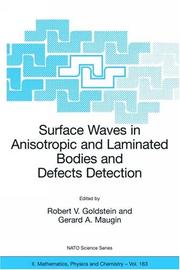| Listing 1 - 1 of 1 |
Sort by
|

ISBN: 128019054X 9786610190546 1402023871 1402023863 1402023855 9781402023866 9781402023873 Year: 2004 Volume: 163 Publisher: Dordrecht, Netherlands ; Boston, Massachusetts : Kluwer Academic Publishers,
Abstract | Keywords | Export | Availability | Bookmark
 Loading...
Loading...Choose an application
- Reference Manager
- EndNote
- RefWorks (Direct export to RefWorks)
Among the variety of wave motions one can single out surface wave propagation since these surface waves often adjust the features of the energy transfer in the continuum (system), its deformation and fracture. Predicted by Rayleigh in 1885, surface waves represent waves localized in the vicinity of extended boundaries (surfaces)of fluids or elastic media. In the ideal case of an isotropic elastic half-space while the Rayleigh waves propagate along the surface, the wave amplitude (displacement) in the transverse direction exponentially decays with increasing distance away from the surface. As a result the energy of surface perturbations is localized by the Rayleigh waves within a relatively narrow layer beneath the surface. It is this property of the surface waves that leads to the resonance phenomena that accompany the motion of the perturbation sources (like surface loads) with velocities close to the Rayleigh one; (see e. g. , R. V. Goldstein. Rayleigh waves and resonance phenomena in elastic bodies. Journal of Applied Mathematics and Mechanics (PMM), 1965, v. 29, N 3, pp. 608-619). It is essential to note that resonance phenomena are also inherent to the elastic medium in the case where initially there are no free (unloaded) surfaces. However, they occur as a result of an external action accompanied by the violation of the continuity of certain physical quantities, e. g. , by crack nucleation and dynamic propagation. Note that the aforementioned resonance phenomena are related to the nature of the surface waves as homogeneous solutions (eigenfunctions) of the dynamic elasticity equations for a half-space (i. e. nonzero solutions at vanishing boundary conditions).
Acoustic surface waves --- Elasticity --- Waves, Acoustic surface --- Waves, Elastic surface --- Elastic waves --- Sound-waves --- Surface waves (Oceanography) --- Ondes acoustiques de surface --- Elasticité --- Congresses --- Congresses. --- Congrès --- Congrés --- EPUB-LIV-FT LIVINGEN SPRINGER-B --- Vibration. --- Surfaces (Physics). --- Crystallography. --- Mathematics. --- Vibration, Dynamical Systems, Control. --- Characterization and Evaluation of Materials. --- Crystallography and Scattering Methods. --- Applications of Mathematics. --- Math --- Science --- Leptology --- Physical sciences --- Mineralogy --- Physics --- Surface chemistry --- Surfaces (Technology) --- Cycles --- Mechanics --- Sound --- Dynamical systems. --- Dynamics. --- Materials science. --- Applied mathematics. --- Engineering mathematics. --- Engineering --- Engineering analysis --- Mathematical analysis --- Material science --- Dynamical systems --- Kinetics --- Mathematics --- Mechanics, Analytic --- Force and energy --- Statics
| Listing 1 - 1 of 1 |
Sort by
|

 Search
Search Feedback
Feedback About UniCat
About UniCat  Help
Help News
News